Clermont Tile Company
on the picture to see it bigger
and interactive
click to see the Kaul Clay advertising
items
click to go back to the map of Clermont
return to Smethport homepage
The plant was built around the
turn of the century and was known as the Clermont Tile Company, the Clermont
Sewer Pipe Company, and finally Kaul Clay until the disastrous fire of
November 21, 1961 destroyed it.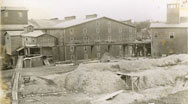
It was a little after 7 p.m. on King's
Row in Clermont. It was growing dark, and the group of children sled-riding
near the Shawmut Railroad grade started for home to prepare for school
the next day. Looking toward the Kaul Clay factory, the kids noticed
a glow. Dorothy and Don Himes ran across their yard to tell their parents,
while Sally Kinney raced two houses further to do the same. And, Jay Confer
hastened home to do the same. All had fathers who worked at the tile factory.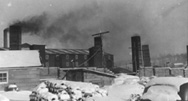
Meanwhile Jim Schnepp, who headed the large United
Natural Gas facility in Clermont, drove up King's and Queen's Rows, blowing his
car horn. The curious ran to their doors. Looking east, all knew the aging wooden
boiler house was ablaze. Soon sirens were wailing as members of the Clermont Volunteer
Fire Department were summoned to the fire hall, the former basement of the
Grand view before a gas explosion leveled it in 1956.
The department had been organized for several years,
and the 1932 Dodge pumper had been pressed into action for several fires on Kaul
Clay's property. However, engine trouble had prevented it from Reaching Tom Walker's
house fire on the edge of the Katrine Swamps a couple years earlier.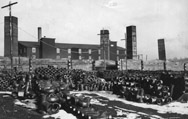
History was to repeat itself. And the events of November
21, 1961 were the final coffin nails in the corpse that was Clermont. Once a booming
metropolis with thoughts of incorporation, it had earlier boasted of several
coal mines, two railroads, four hotels, pool parlors, taverns and shops of all
kinds.
The coal mines were abandoned as cheaper coal could be mined
elsewhere. Still, the former Clermont Sewer Pipe Company, in existence
since the turn of the century, employed people from as far as Kane, Smethport
and Port Allegany.
 While
plastic pipes had killed the sale of clay sewer pipes, there was still
a market for the refractories the plant fired for the Pittsburgh steel
mills. These hot tops were the bread and butter for the 85 Kaul Clay employees.
While
plastic pipes had killed the sale of clay sewer pipes, there was still
a market for the refractories the plant fired for the Pittsburgh steel
mills. These hot tops were the bread and butter for the 85 Kaul Clay employees.
As the flames leaped from the tinderbox, there was hope the local
volunte4ers could save the four-story structure. With fire hydrants nearby, including
by the fire hall less than 100 yards from the blaze, there was cause for optimism.
Moreover, a large pond sat below the factory, and there was no truck in the county
that could draft faster than Clermont's Dodge.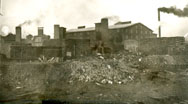
However, it never got a chance to show what it
could do. Stories are conflicting, and memories muddled. Be it a dead battery,
or a flat tire, or engine problems, the blaze went unchecked. A mutual aid call
went out, and sirens screamed through the night from Mt Jewett, Smethport, Kane
and Hilltop. Over 75 volunteers attacked the inferno.
It was soon decided the building was a loss,
as shingles and burning boards were hurdled hundreds of yards. The heat
was so intense Dolores Kinney , who lived several hundred yards away, remembers
her porch railings were too hot to touch. Her husband Gerald, and her brother
Marvin (Bill), ran to the boiler room, recalling a fellow employee kept
a dog in there.
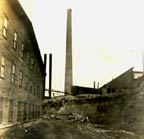 Foreman
Iroe Dibler ordered Leonard Henderson to get the fork lifts out of the structure.
He was quickly told he could do that job himself. Across the street Elawese Himes
watched in horror. Just yards from her house, the flames were spewing embers.
Firemen soon directed their efforts at cooling the homes along Main Street, as
well as those Yoder and Cecchi homes just south of the factory.
Foreman
Iroe Dibler ordered Leonard Henderson to get the fork lifts out of the structure.
He was quickly told he could do that job himself. Across the street Elawese Himes
watched in horror. Just yards from her house, the flames were spewing embers.
Firemen soon directed their efforts at cooling the homes along Main Street, as
well as those Yoder and Cecchi homes just south of the factory.
Soon the building was rubble, and the weight of the hot tops sent the floors crashing.
In the kiln yard, the night shift struggles to save what they could. That night
the kilns were fired for the last time.
Volumes of black smoke filled the air, and
the glaring red could be seen as far away as Smethport. Reports of an explosion
soon brought ambulances from Smethport, Kane and Mt Jewett, but there were
no injuries. About 9:20 p.m. the community lost power, but few noticed
as all were outside, hypnotized by the destruction.
The next few days employees cleaned rubble. Inventory
was brought from the sister plant in Toronto, Ohio to meet demands. There
were hopes of reopening the factory, but sales had dropped $150,000 in
the past year. By Christmas there was one maintenance man, seven
yard men, and two men maintaining the kilns. It was a bleak Christmas in
Clermont in 1961.
Over the years the inventory was gradually sold. Eventually
the frame company houses were also sold, most to become hunting camps. And, in
mid-1988 the Kaul Clay Company filed dissolution papers. Once the lifeblood of
a thriving community, it was now a pile of rubble. Today's trees grow where kilns
stood, and little remains as a reminder. Damage was estimated at $600,000 but
the real cost to Clermont could not be put in dollars and cents.



 While
plastic pipes had killed the sale of clay sewer pipes, there was still
a market for the refractories the plant fired for the Pittsburgh steel
mills. These hot tops were the bread and butter for the 85 Kaul Clay employees.
While
plastic pipes had killed the sale of clay sewer pipes, there was still
a market for the refractories the plant fired for the Pittsburgh steel
mills. These hot tops were the bread and butter for the 85 Kaul Clay employees.

 Foreman
Iroe Dibler ordered Leonard Henderson to get the fork lifts out of the structure.
He was quickly told he could do that job himself. Across the street Elawese Himes
watched in horror. Just yards from her house, the flames were spewing embers.
Firemen soon directed their efforts at cooling the homes along Main Street, as
well as those Yoder and Cecchi homes just south of the factory.
Foreman
Iroe Dibler ordered Leonard Henderson to get the fork lifts out of the structure.
He was quickly told he could do that job himself. Across the street Elawese Himes
watched in horror. Just yards from her house, the flames were spewing embers.
Firemen soon directed their efforts at cooling the homes along Main Street, as
well as those Yoder and Cecchi homes just south of the factory.